ABSTRACT
The academic contributions of Bruno Latour are significant and must be explored. Today, the contemporary tools, such as bibliometric analysis and systematic review provide great opportunity to do so. Findings, using these tools, help understand, for example, the hotspots and trends in research that translated Latour’s scholarly contributions. Latour’s research publications peaked in 2016, with the highest of twenty-five social sciences publications, spread in twenty-six countries. The three-field plot and co-word occurrence map illustrate his emphasis on Actor-Network Theory (ANT). The diverse applicability of Latourian ANT has an interdisciplinary impact in science and technology studies, ecology, and contemporary global issues. Latour’s oeuvre is also applied in Indian context. In providing counter-arguments on the criticisms of Latour, we delineate that his scholarship has brought a paradigm shift, especially in scientific epistemology. This is why our research will be useful for social scientists across social contexts.
INTRODUCTION
Bruno Latour (1947-2022) was a French-origin anthropologist of science, philosopher, and sociologist. He was the recipient of the prestigious Holberg Prize in 2013 and Kyoto Prize in 2021. Harman[1] credited Latour as a meta-physicist. As a social constructivist, Latour denies accepting the scientific facts as given and uncovers the practices of scientific communities in constructing these facts.[2] Salinas[3] shows Latour’s approach as pragmatic realism, beneficial in understanding the relations between humans and non-humans. Latour is a complex author- his writings are ornated with ironic sentences, ontological assumptions and enriching scholarly references. One of the reasons for his complexity may be his interdisciplinary standpoint. During his early career at the Paris School of Mines (1982-2006), Latour proposed Actor-Network Theory (ANT) that explains the interconnected alliances between scientists, technological artefacts, and scientific knowledge.[4]
With the passage of time, Latour’s concepts have become popular in the academic professoriate. Not restricted to ANT, his academics expanded to myriad aspects of science, law, transport systems, religion, environment, politics, and limits to growth, to name a few. He is a stalwart in blurring the disciplinary boundaries for scholars and acknowledging the roles of human and non-human agents in knowledge production. Latourian scholarly frameworks are utilised for diverse empirical works. For instance, his scholarship was deployed to decipher the expanse of a district health information software for several developing countries,[5] and his oeuvre supported the data gathered from satellite images in India.[6]
Aim of the present paper is to comprehend the scholarly contributions of Latour as a scientist, using latest computational method. Concurrent tools like bibliometric analysis and systematic reviews can be used to show the impact of Latour’s contributions. Bibliometric analysis shows the vast connections and global networks within the extant literature on a particular topic of interest.[7,8] Whereas through systematic reviews, we can aggregate results from vast research records. Deploying such tools makes research hotspots and contemporary research trends identifiable. Bibliometric analysis and systematic reviews are especially useful for social scientists to position their arguments in line with the recent academic trends. These tools can be used to situate the significance of Latour’s contributions in developing social science research. The specific objectives are to understand the spread and depth of academic contributions by Latour and use the methods such as systematic review and bibiliometric analysis.
The Process
The research design of the paper is categorised under bibliometric analysis and systematic review. Bibliometric analysis allows building a systematic knowledge pool wherein the emergence, spread, and paradigm shifts of any research theme can be analysed. Since 1958, post the foundation of the Institute for Scientific Information, bibliometric indicators have played a pivotal role in assessing the new intellectual domains of research.[9] Bibliometric analysis is replicable and valid across citation databases. The well-accepted softwares include BiblioShiny platform from the Bibliometrix R-package, CiteScpace, SciMat, and VOSviewer.[8–10] In this research, BiblioShiny interface from the Bibliometrix R-package and VOSviewer were utilised. These two softwares are coherent in representing the applicability, association, distribution, relevance, and trend of Latour’s contribution across the threads of academia. Compared to the other bibliometric interfaces, BiblioShiny and VOSviewer are appropriate to undertake qualitative explorations, instead of complex programming or statistical tools. BiblioShiny is attainable for non-coders, particularly in social science disciplines for building data matrices and demonstrations on bibliometric details. VOSviewer is especially useful to graphically illustrate large bibliometric maps.[11] Various aspects of bibliometric information on the authors, citations, journals, keywords, and others become thematically accessible through maps generated in VOSviewer. Techniques of bibliometrics in these two softwares include bibliographic coupling, co-author analysis, co-citation, co-word analysis and others.
Along with bibliometric analysis, we used a systematic review, which is considered one of the new developments in reviewing existing literature on any theme. Systematic review is the usage of explicit and systematic methods to search for reliable findings from a pool of studies, with minimum bias.[12] Such reviews summarise national and international evidence on relevant questions and are effective for policy, practice, or research. The articles for systematic review are retrieved under the Preferred Reporting Items for Systematic Reviews and Meta-Analyses (PRISMA) framework.[13] PRISMA summarises the literature on a desired matter, highlighting the contemporary research trends and/or gaps. Documents for bibliometric analysis and systematic review are screened through a search strategy. A nuanced rationale of the inclusion and exclusion criteria utilised to filter the selected studies is provided (Figure 1), where ‘n’ denotes the number of articles.
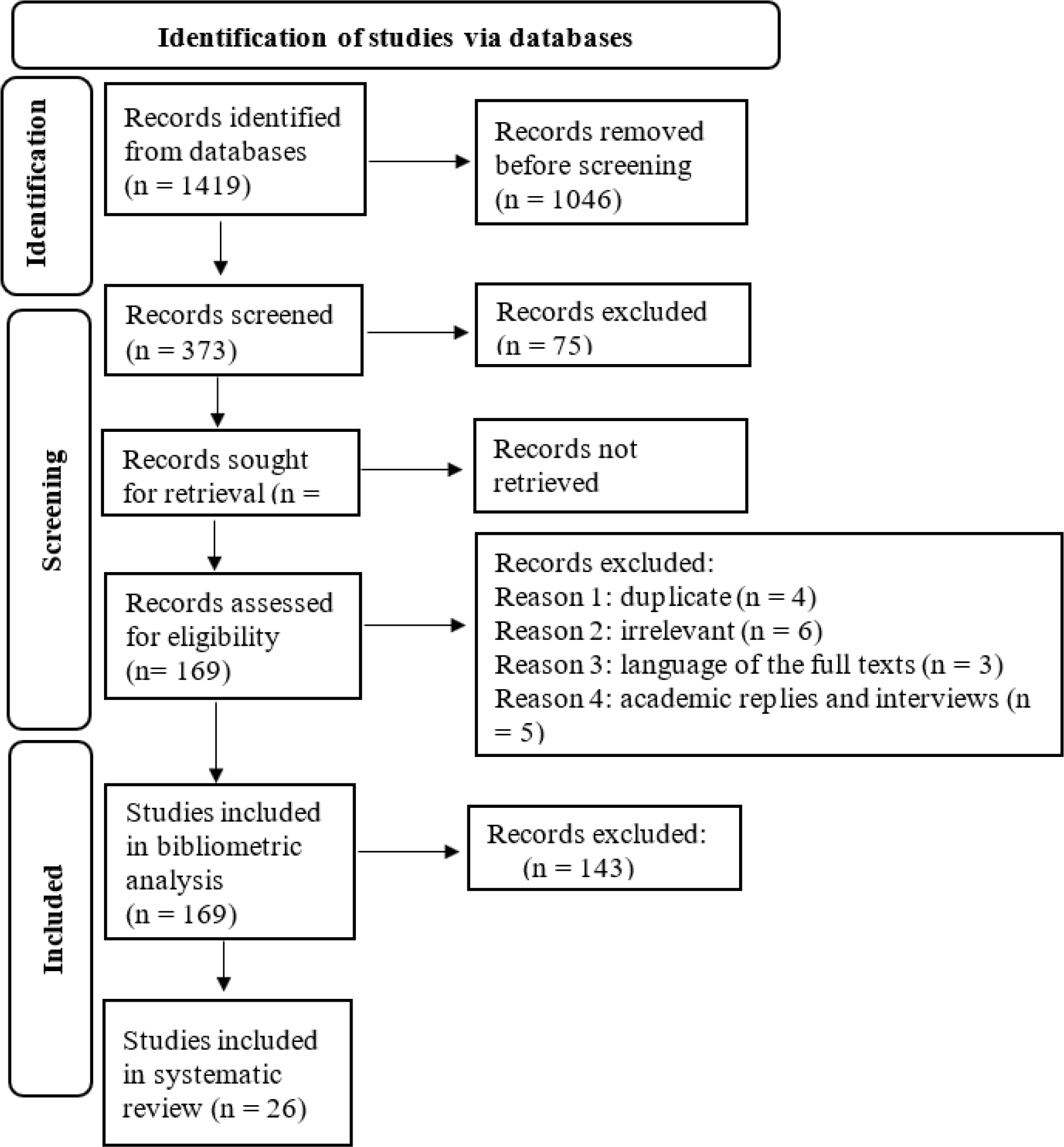
Figure 1:
Search strategy to retrieve documents for bibliometric analysis and systematic review.
We performed the initial search in eight databases (Table 1), and the criteria were to have the word ‘Latour’ in the document title. This stage of the title search depicted a true picture of the range of studies based on Latour’s scholarly contributions. The maximum publications were witnessed in JSTOR. However, metadata retrieved from JSTOR could not be assessed through any bibliometric tool because of limited scope in the bibliometric softwares and incompatibility of JSTOR with the softwares. Two databases, namely, Scopus and Web of Science were accessible in both BiblioShiny and VOSviewer. Since, at any given point, only one database can be examined in the bibliometric interfaces. Hence, we selected Scopus (Elsevier) for further analysis, having the second highest collection of literature, after JSTOR. It consisted of 373 manuscripts on Latour across the contents of engineering, humanities, natural sciences, and social sciences. Seventy-five of these were written in eleven non-English European languages, such as French, German, Spanish, Portuguese, Russian, Italian, Polish, Croatian, Dutch, Slovenian, and Swedish. Although it establishes the popularity and impact of Latour’s scholarship in European academia, we chose those publications in English because of its current international coverage and the authors’ English language competence. Among the 298 English language communications, 190 were from social sciences disciplines. Subsequently, Latour’s concepts have also been referred to in science and technology studies. Since Latour was a social scientist and a meta-physicist, our research revolved around the impact of Latour in social science disciplines.
| Database | Frequency of publications |
|---|---|
| JSTOR | 551 |
| Scopus | 373 |
| Web of Science | 235 |
| Directory of Open Access Journals | 107 |
| Sage | 78 |
| ScienceDirect | 41 |
| PubMed | 22 |
| Education Resources Information Centre | 12 |
The next stage of screening eliminated four duplicate and six irrelevant articles after manual checking. Irrelevant documents concerned with other scholars having similar name as Latour, were avoided. Three articles published in 2011, 2016 and 2020 were excluded- pertaining to their abstracts in English but, full text in German and Spanish languages. Five academic replies and interviews from Latour, contained his own authorship and were hence removed- because these would seize to portray his influence on other bodies of research. Moreover, three publications with no author, in the form of editor’s note or interviews were deleted from the cluster of bibliometric information. Finally, 169 records were refined for bibliometric analysis.
For systematic review, we retrieved manuscripts having the most deployed keywords. Three keywords- ‘Latour’, ‘Bruno Latour’ and ‘actor-network theory’ were the most utilised in the selected documents. Among these three terms, ‘actor-network theory’ indicated towards a concept, and the former two words only suggest the concerned author. The systematic review traced the publications rendering on ANT with all possible spellings such as ‘Actor-network Theory’, ‘Actor Network Theory’, ‘Actor-network-theory’, ‘ANT’, ‘Actor-Network Theory (ANT)’, ‘Actor network’, and ‘Actor network Theory’. Hence, the authors narrowed down to twenty-six articles for the final review (Figure 1).
Review analysis of Latour’s scholarship
Bibliometric analysis
Our comprehension of the bibliometric insights from 169 studies was analysed through keyword co-occurrence or co-word analysis, spatiotemporal distribution of discourses, and three-field plot on the network of authors’ relevant work in published sources.
Co-word analysis
Keywords translate the pivotal arguments in the documents. Co-word analysis is rooted in the matrix of similarity generated from the keyword co-occurrences.[14] Latour’s expanse on the academic disciplines is understood from the co-word analysis of publications between 2012 and 2018 (Figure 2). This timeline depicts the contemporary research hotspots based on the automated algorithm of VOSviewer. The weightage of all nodes exhibits a multiplicity of keywords. Bigger nodes with higher radii suggest greater usage of a particular operative word. Based on average publications per year, these nodes have a minimum value of two. Links joining each keyword demonstrate connections between manuscripts- links with greater width join keywords with higher frequency. The largest two nodes in Figure 2 display the keywords ‘Latour’ and ‘Bruno Latour’, with the strongest link strengths of 176 and 166, respectively. Primarily published between 2014 and 2016, the former term appears in thirty-two communications, and the latter in thirty-one records. The keyword ‘actor-network theory’ has the third highest co-occurrence, with a total link strength of ninety-six. ANT indexes sixteen studies, majorly published around 2016. Research related to terms such as ethics, disaster, morality, psychiatry, anthropology, history, and others are marked in blue tint and are predominant from 2012 to 2014. The arguments associated with ontology, modes of existence, critique, science, education, anthropocene, constructivism, and others, emerged during 2017-2018.
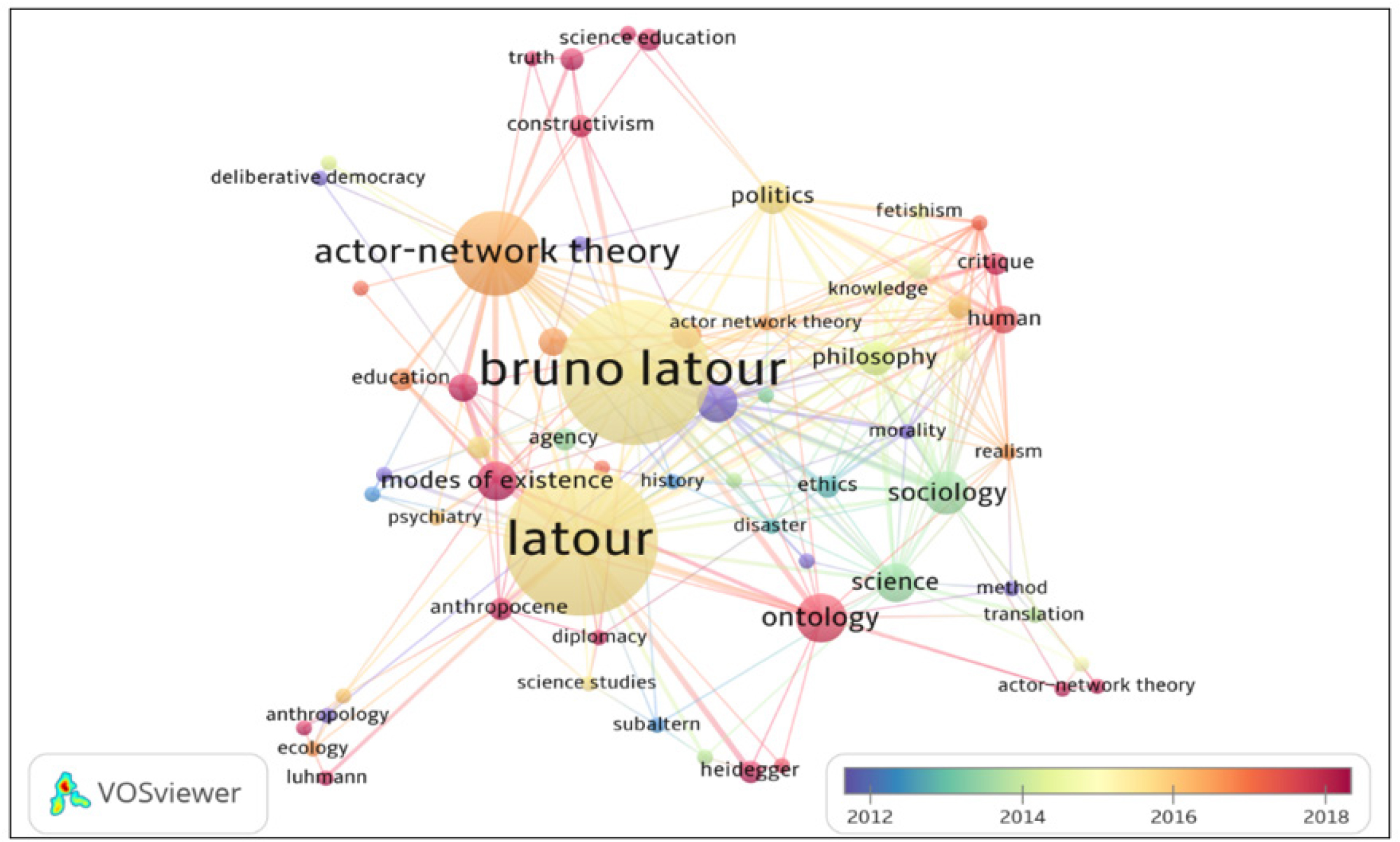
Figure 2:
Co-word analysis of research literature.
Temporal analysis
A nuanced temporal distribution of the considered studies is depicted in Figure 3. The selected research literature was published between 1988 and 2022, with the first peak of publication with seven manuscripts in 2005. Few articles published in this year adapted Latour in understanding archaeological artefacts;[15] questioned the conventional sociological narratives through Latour’s ethnomethodology;[16] and compared Bourdieusian analyses with Latorian ANT.[17] In 2016, twenty-five records were published on themes such as the transformation of social to socio-material pathologies using Latour’s subjectivity;[18] maintaining the scientific, social, and philosophical stances in the evolution of Latour as a metaphysicist;[19] and comprehending his contribution in policy translations, depicted through a case study from Latin America.[20]
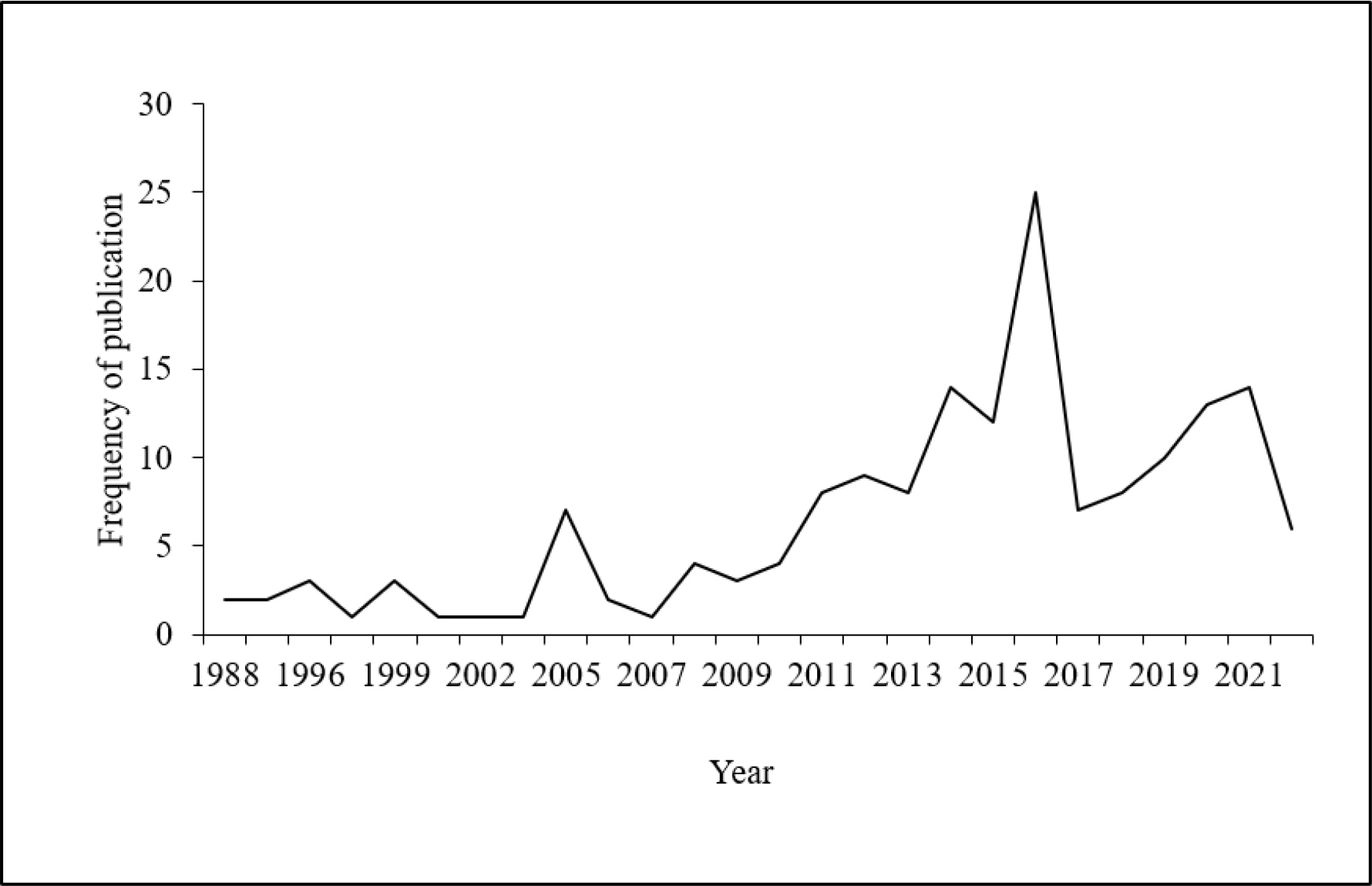
Figure 3:
Temporal distribution of research literatures.
Spatial distribution of scholarship on Latour’s contribution
It highlights twenty-six countries where scholars diffused Latour’s contribution in academic domains (Figure 4). The map devised by BiblioShiny illustrates the extensive research flourishing on his contribution. It is prominent in developed countries, including-Canada, Netherlands, Australia, Germany, Belgium, France, South Korea, and others. The United States of America (USA), followed by the United Kingdom (UK), emerged as prime locations for pursuing such research-evident in sixty and thirty-eight publications, respectively. There is a skewed frequency of these records in developing countries. This shows a need for further research to be inspired from Latour’s scholarship, in these regions.
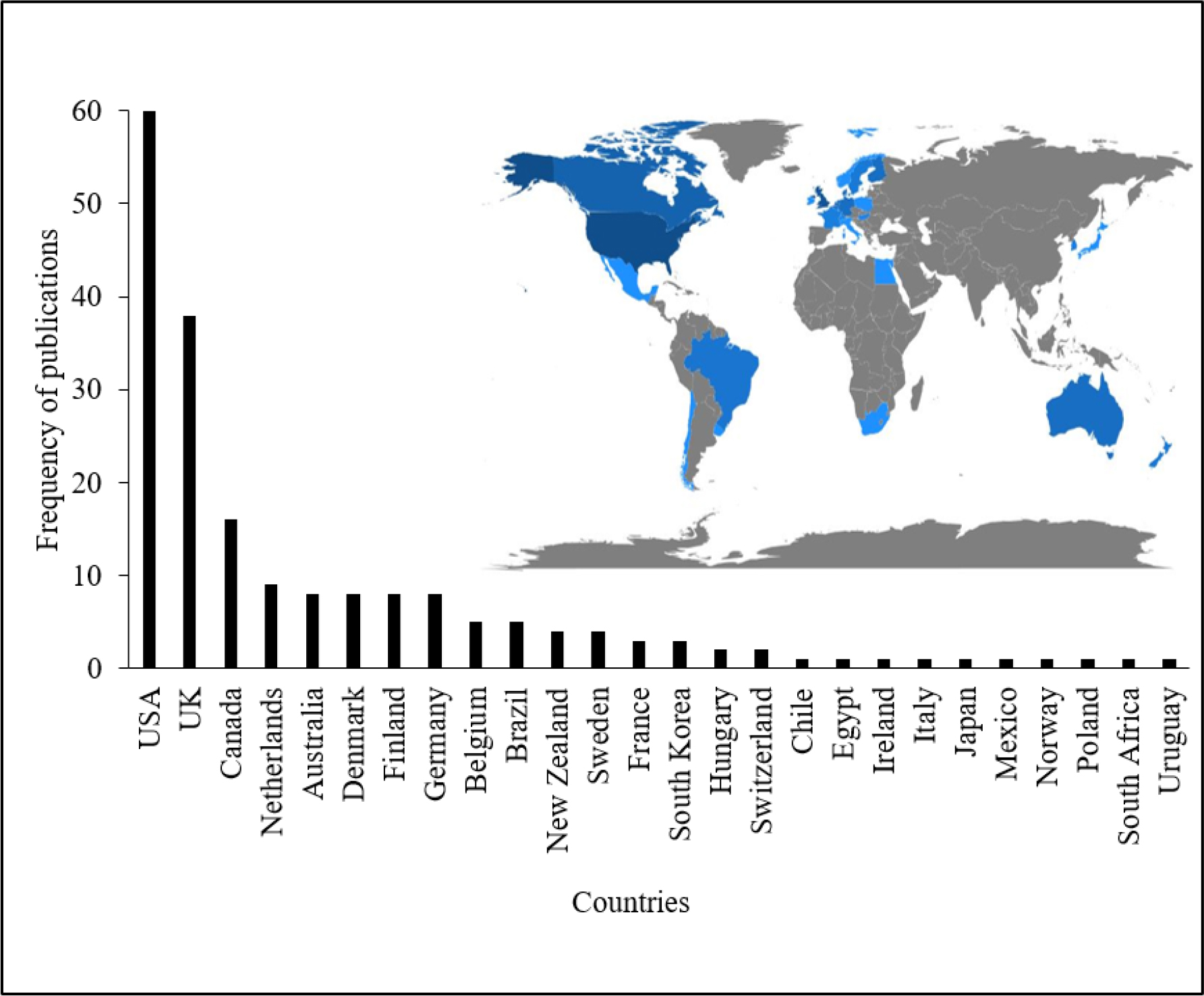
Figure 4:
Spatial distribution of research literature.
Country-wise citation analysis
In Figure 5, the nodes’ radius shows the range of citations from a country’s publications. Countries such as the USA, UK, and Canada have higher citations depicted by nodes with higher radii. Citation frequencies of these countries are 438, 208 and 245, respectively, as generated from VOSviewer. The width of links joining these nodes depends on the citation count of individual manuscripts produced from the source country and their bibliometric connections to other countries. Here, the citation links connect the representative countries with a linkage of at least two academic writings. Total citation link strength is the highest in the UK, with a frequency of twenty. Most cited papers are rooted in the institutes of the UK- advocating efficient utilisation of Latour’s scholarly contribution in this region. Links generated from this node also portray the strongest citation connections of documents from the UK to countries such as Australia, Belgium, Canada, Denmark, Germany, USA, and others. The citations from these linked articles also remain high. Scientific productions from Denmark and the USA have a citation link strength of twelve. This value for Germany is eleven-suggesting an accelerated citation.
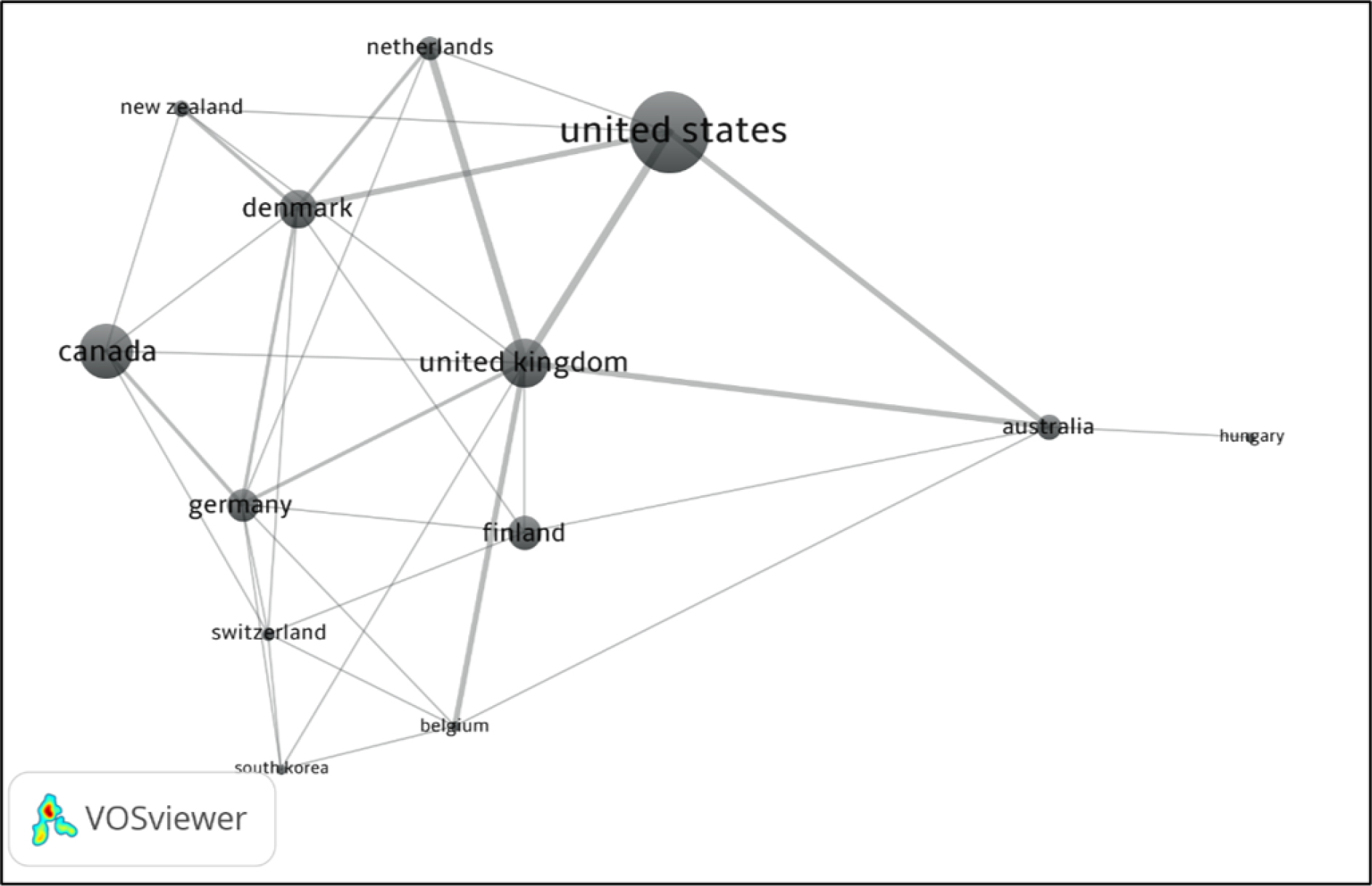
Figure 5:
Country wise citation analysis of Latour’s contribution.
Three-field plot
Three attributes of the three-field plot (Figure 6) generated from the BiblioShiny interface are- keywords (DE), source or journal (SO) and author’s name (AU). It presents the research literature associated with certain distinguishable keywords in relation to their source of publication and authorship. Linkages between these three elements are depicted by the lines with differing widths joining each variable. Nine sources and five authors are identified as analogous to the ten predominant keywords. These ten operational terms resemble the trend of research that deployed Latour’s scholarship. Here, the terms such as actor-network theory, modes of existence, modernity, ontology, technology, and others directly reflect his concepts. This plot reinforces ‘actor-network theory’ as the keyword with the third highest frequency, after the terms such as ‘Latour’ and ‘Bruno Latour’. Social Studies of Sciences is identified as the prime journal publishing studies with prominent keywords.[21,22] The contributions of five authors are summarised through ten pivotal terms and are published in nine journals. Among them, M. C. Watson’s intellectual development on Latour is evident in two journals: Global Discourse[23] and Theory, Culture & Society.[24,25] However, Latour’s impact remained restricted to the journals and scholars associated with the developed world.
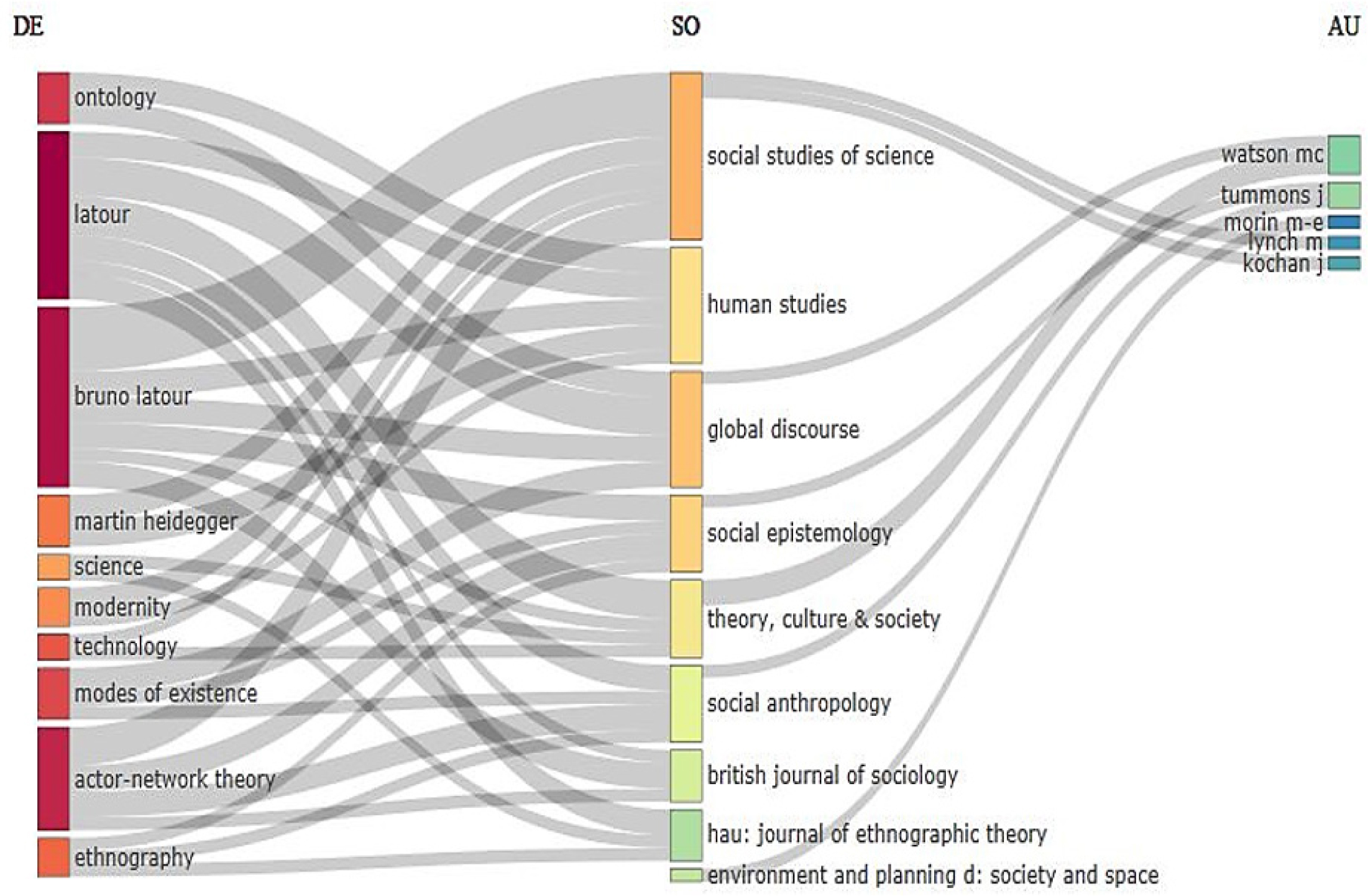
Figure 6:
Three-field plot on keywords, sources and authors.
Systematic review
Drawing from the Scopus database and bibliometric analysis (Figures 2 and 6), ANT appears as a vivid concept from Latour’s academic contributions. For systematic review we include the descriptions, translations, and critique of ANT from the retrieved twenty-six documents. The explanations and evolution of ANT have been drawn from the screened documents and these arguments are substantiated from Latourian scholarship as well. We have directly referred to the pivotal contributions of Latour to strengthen the initial understanding of ANT. Moreover, the application and critical appreciation of ANT is purely derived from the twenty-six publications.
Actor-Network Theory (ANT)
ANT envisages people and networks as co-extensive. An actant is anything or anyone upon whom an activity is granted; someone or something who consumes, acts, responds, or evolves by a stimulus from another actor. Networks are dynamic and produce translations even within static landscapes.[26] Lecomte[27] interpreted the hyphen in actor-network theory, suggesting that actors constitute complex heterogeneous networks and are mutually influenced. Researchers adopting ANT display the role of human and non-human actors in accomplishing networks.[28–31]
ANT visualises individuals by virtue of their associations or networks. It ceases to rank actors in local-global or micro-macro levels[32] and implies beyond vertical or horizontal hierarchy. This theory pursues the interconnections of human and non-human entities across geographic, cultural, and political spaces. It is also understood through infra-theory, that does not merely rely on the observer’s notion or priori constructs.[33]
Inception and evolution of ANT
Depicted in the book Laboratory Life: The Social Construction of Scientific Facts, by Latour and Woolgar,[34] ANT surfaced in the Paris School of Mines. This book shows Latour’s ethnography of scientists in action, referencing Thomas Kuhn’s Structure of Scientific Revolutions.[35] It advocates the foundation of scientific laws that emerge in the laboratories and transforms them into factual statements through publications.[36,37] Acolytes of Kuhn and Latour consider science a cultural practice- constructed by scientists.
Latour has evolved as a scholar, wherein his arguments on ANT transmuted from denying reductionism to accepting translations of actions between actors and networks. Edward[38] conceptualised these advancements as the four consequences of ANT: irreductionism, rejecting correlations and dichotomies, making society non-existent, and perceiving transportation with translation. Latour’s philosophical denial of reducing elements or scaling actors developed the principle of irreductionism. He endorsed flat ontology to overrule two notions of reductionism, namely-ontological and methodological. He provided ontological standpoints to mundane elements, and nullified scaling of components into atoms. Dewey’s concept of ‘transaction’ is the antecedent of flat ontology, as it critiques the dualisms between humans and their natural environment.[39] The post-structural ANT imbibes flat ontology. It espouses heterogeneous humans, non-humans, hybrids, and networks[40,41] under the principle of symmetry. Latour expanded the symmetry between humans and non-humans through his book titled An Inquiry into Modes of Existence.[42] The second consequence discards correlations, dichotomies, and binaries, and promotes monism.[43] In his pioneering book, We have never been Modern,[44] Latour recommended withdrawing from the distinctions between humans and nature. He moves past the subject-object dichotomies of nature-culture, mind-body, human technologies, and others.[45] Adhering to the neoliberal views of Latour, the third consequence of ANT dismisses society’s existence, its pseudo appearance and necessity. A reflection of this becomes prominent when the term social is removed from the title of the second edition of Laboratory Life by Latour and Woolgar.[46] Finally, the fourth consequence is that ANT translates actors’ post-structural interactions, influences, and effects. There is no transportation of actions without translation between actors and networks.
Application of ANT
Latour’s interdisciplinary impact
Edward[38] borrowed from Harman[1] to justify the applicability of Latour’s contribution in different fields of academia. In education research, ANT is deployed to various subjects, from physics to management studies.[47] He validates elements across academic domains on the same plane and negates disciplinary boundaries between science, law, economics, politics, and others.[3] Particularly, ANT challenges the compartmentalisation of social sciences. Schiølin[48] regarded the descriptions of ANT in linguistic disciplines. One such context assumes the actions that shape reality corresponding to the verbs converted from nouns.
Science and Technology Studies (STS) and Ecological interpretations
At the human-technology interface, ANT summarises the mediations that subjugate humans under technologies. There are four forms of mediations in human-technology interactions.[39] It starts with a translation, in which humans tend to detour when getting involved with non-humans (developing a technological artefact). Thereafter, a composition of myriad human and non-human elements is created. This is followed by the third form of mediation, which is black-boxing. Here the steps of technology creation are subsumed by the final output. For example, the formation of a fact from a theory; or the adoption of any product whilst remaining ignorant of its underlying technology and individual efforts of construction. Finally, the delegation stage induces a complete overtake of technologies upon humans.
Salter[49] restated the securitisation theory as the security actor-network theory. This epistemological turn focuses on the connections between people, crises, disasters, and threats- signifying the role of non-human actants during a calamity. The relevance of ANT is witnessed in disaster management. It becomes applicable in apprehending threats of a natural disaster. Actors during a natural disaster include wind, water, or fire alongside incorporate the emergency services, organisational roles, and human responses in combating such scenarios.[45] ANT and political ecology can be clubbed to interpret an environmental crisis. Whiteside[50] viewed an environmental crisis as a lacuna in the representative politics of nature- it necessitates consideration of actors and their doings.
Latour in contemporary global issues
ANT has been applied to issues of contemporary pertinence across the globe. As adapted by Vadrot and Pohoryles,[51] ANT is significant in assessing the development of biogenetic fuels. It envisages the associated relations between developed and developing countries. Also, the theory of circulating references has been applied to analyse the growth of District Health Information Software by Microsoft.[5] It was deployed in developed and developing countries, focusing on India, Sierra Leone, and Kenya, to understand health information systems globally. Other translations include comparisons between cooperative establishments in India and Australia to show Latour’s scale-less vision of the world.[52] Results indicate similarities between the Eka Nari Sangathan cooperative in Odisha, India, and Norco Dairy in Australia. These are connected by climate change issues and extractive interventions. It goes beyond the local or global boundaries linking contemporary issues such as sustainable development and ecological crisis.
Latour in the Indian context
Latour has been predominantly adopted in the America and Europe- reflected in the language and source of such scholarly insights. It stays under-utilised in the context of developing countries such as India. Through historic and contemporary times, India has remained one of the core regions of knowledge production. Hence, we conducted a separate search of extant literature to comprehend Latour’s impact on Indian academia. Latour, in India, has been conceptualised in literatures including development, industries, ecology, medicine, and other aspects. Robbins[6] investigated the modernising of the semiarid Godwar region of Rajasthan, India, through the lenses of Latour. Attempts to develop the Godwar region partitioned the area into social and natural land covers. Despite several interventions from the state to delineate boundaries of social and natural areas, there were unexpected land-cover changes resulting in the merging of the two regions. It indicates the inefficiency of binary considerations (social or natural) for regional development. In another article, the cotton plantation farmers from Telangana, India, utilising Genetically Modified (GM) seeds, are envisaged under the spectrum of factish, STS, and ANT.[53] The reality of GM seeds lies beyond the agricultural field and is more extensive than the interpretations of biotechnologists, economists, policy-makers and other stakeholders. Latour’s notion of factish, builds on the translation of scientific facts. It allows an understanding of the subjectivities of the farmers and GM seeds. STS aids in grasping the black-boxing of farming-related subjective ideas, whilst accepting the objective technology associated with these high-yielding seeds. ANT becomes imperative in decoding the construction of scientific narratives on such an agricultural development.
Similarly, Rawat & Morris[54] offered a reflection on the largest national biometric identity programme in India, with support from ANT. India developed Aadhaar cards, attributed with biometric records for the entire population. These are characterised by a twelve-digit unique identification number, denoting individuals’ identity, and address details. This theoretical construct described the trajectory of the complex Aadhaar cards initiative in India. ANT acknowledges a multitude of humans, nonhumans, technologies, and their cumulative actions resulting in the successful implementation of the Aadhaar project. Such a development is executed because technology mediated through policy advancements.
Latour has been conceptualised in Indian Ayurveda. Emerging in the Indian state of Kerala, Ayurvedic psychiatry is considered as a relevant actor by Lang.[55] Indian Ayurveda is interpreted within the framework of purification and translation under Latour’s concept of the modern constitution. Indian archaeology and recent developments associated with the country’s heritage are also depicted through his theories. The Place-Hampi project of India elaborates an entanglement between people and things from Latour’s perspective.[56] This project developed on the interactive environments among humans and non-humans (technologies). It derived a narrative sense from the actions of heterogeneous agents and enabled an advanced visualisation of heritage.
Critical appreciation of ANT
Flat ontologies and apolitical approaches by Latour received critical remarks.[57] Latour’s rejection of society and acceptance of all objects on a flat ontology, brought him to the forefront of criticisms. Scholars have reproved his presumed disinterest in acknowledging power relations.[58] Latourian irreductionism ignored human abilities to employ intelligence, emotions, or ethics. Schiermer[59] suggested that Latour did not consider the forms of social forces that govern humans.
ANT is criticised for disregarding the causalities and asymmetric social formations. Disapproval faced by this framework includes a lack of conceptualisation of capital, power, and class. Kaczmarczyk[60] critiqued ANT and labelled it as strictly materialist and radicalistic. Waelbers and Dorstewitz[39] highlighted the ethical lacunas in ANT- where actions of humans and non-humans are narrated in a third-person vocabulary. This makes the theory complex, yet flat and reductionist.
However, paying close attention to these criticisms uncovers a misinterpretation of Latour’s discourses. Latour took support from empirical philosophy to pursue real-world problems.[4] He considered the nuances of micro-sociology. His cosmology accepts the diverse roles of natural and material objects. He also denounces any sense of pre-existing social reality.[61] Appreciating Latourian apolitical theory of society brings a pseudo-relief from the sufferings of modernity.[62]
ANT does not rely on the narratives of universal truth.[63] Engaging with ANT serves as a counter-revolution for conventional sociological work. It dodges positivism and radical constructivism, proffering the interrelationships between scientists, facts, theories, humans, and non-humans. Kale-Lostuvali[64] argued that Latourian ANT blurs the boundary between science as a social practice and reality as a non-social entity. It builds an understanding on how scientific work is constituted through the enunciation of facts and reality.
CONCLUSION
The present paper envisions Latour’s scholarship as multi-dimensional. His pivotal arguments regarding the formation of reality ensue a constant dialogue between humans and non-humans. It is evident from the bibliometric analysis that the impact of his treatise proliferated over time and across scholarly disciplines. Within the selected studies, a peak of intellectual contributions was registered in 2016 (Figure 3). Latour’s career is shaped in the USA and European countries such as Germany, Denmark, Belgium, and others. Academic institutions in the USA take support from his oeuvre, keeping this country at the zenith of the screened publications (Figure 4). The selected documents are predominantly rooted in institutions and journals from Europe and the USA (Figure 6). Adaptations of his frameworks are prominent but not limited to developed nations. Among all the theories of Latour, ANT was primarily adapted by the research communities.
We conducted a systematic review to summarise ANT and the related trends in research. The review suggests that Latour advocated flat ontology and comprehended the construction of science. He highlighted the processes that shape scientific advancements and explored the transformation of scientific inventions to facts. He situated science and technology equivalent to the scientists’ actions and simultaneously brought humans, nonhumans, and technological artefacts under flat ontology. We assessed the influence of Latour in education, STS, ecology, and global contemporary issues. Latour’s philosophical applicability briefly extends to developing countries such as India and presents a wide scope of future research on this theme.
The bibliometric softwares have limitations as they allow only a few selected databases to be computed distinctively. Also, an amalgamation of metadata retrieved from multiple scholarly databases remains inaccessible in the bibliometric interfaces. Hence, at a time only one database can be analysed through these softwares. Moreover, records outside the selected set of research literature are not considered, except documents utilising Latour in the Indian context.
The software-generated objective techniques in bibliometric analysis and systematic review attempt to capture the Latourian post-structuralism. It may become an exception when considered purely from a qualitative perspective. Instead, this research should be viewed with a mixed methods approach that strives to interpret Latour’s impact through contemporary tools. Our bibliometric and systematic review methods can be replicated by other future researchers across academia. Scholarly contributions, interdisciplinary trends, paradigms of knowledge production, and geographic variation of research on a particular theme can be studied through these methods. Deploying the tools for bibliometric analysis and systematic review also aids in identifying the research gaps on which future studies can be based. This helps trace the scientific developments in several academic domains across time-space dimensions.
Cite this article:
Sarkar A, Raj A. Review and Analysis of Latour’s Scholarship. J Scientometric Res. 2025;14(2):695-705.
ACKNOWLEDGEMENT
This paper is funding by an ongoing project of the Indian Council of Social Sciences Research (ICSSR), with project number: 02/185/2022-23/RP/MJ.
References
- Harman G.. Prince of networks: Bruno Latour and metaphysics.. 2009.
- McArthur D.. Is Pickering’s “pragmatic realism” viable? Dialectica.. 2003;57(1):71-88. [CrossRef] | [Google Scholar]
- Salinas FJ.. Bruno Latour’s pragmatic realism: an ontological inquiry.. Glob Discourse.. 2016;6(1):8-21. [CrossRef] | [Google Scholar]
- Bruno Latour WS. Nature.. Array;611(7937):661 [CrossRef] | [Google Scholar]
- Sahay S, Sæbø J, Braa J.. Scaling of HIS in a global context: same, same, but different.. Inf Organ.. 2013;23(4):294-323. [CrossRef] | [Google Scholar]
- Robbins P.. Tracking invasive land covers in India, or why our landscapes have never been modern.. Ann Assoc Am Geogr.. 2001;91(4):637-59. [CrossRef] | [Google Scholar]
- Ellegaard O, Wallin JA.. The bibliometric analysis of scholarly production: how great is the impact?. Scientometrics.. 2015;105(3):1809-31. [PubMed] | [CrossRef] | [Google Scholar]
- Aria M, Cuccurullo C.. Bibliometrix: an R-tool for comprehensive science mapping analysis.. J Inf.. 2017;11(4):959-75. [CrossRef] | [Google Scholar]
- Liu Z, Yin Y, Liu W, Dunford M.. Visualizing the intellectual structure and evolution of innovation systems research: A bibliometric analysis.. Scientometrics.. 2015;103(1):135-58. [CrossRef] | [Google Scholar]
- Quintero-Quintero W, Blanco-Ariza AB, Garzón-Castrillón MA.. Intellectual capital: a review and bibliometric analysis.. Publications.. 2021;9(4):46 [CrossRef] | [Google Scholar]
- Van Eck NJ, Waltman L.. Software survey: VOSviewer, a computer program for bibliometric mapping.. Scientometrics.. 2010;84(2):523-38. [PubMed] | [CrossRef] | [Google Scholar]
- Munn Z, Peters MD, Stern C, Tufanaru C, McArthur A, Aromataris E., et al. Systematic review or scoping review? Guidance for authors when choosing between a systematic or scoping review approach.. BMC Med Res Methodol.. 2018;18(1):143 [PubMed] | [CrossRef] | [Google Scholar]
- Page MJ, McKenzie JE, Bossuyt PM, Boutron I, Hoffmann TC, Mulrow CD, et al. The PRISMA 2020 statement: an updated guideline for reporting systematic reviews.. BMJ.. 2021;372:n71 [PubMed] | [CrossRef] | [Google Scholar]
- Nova-Reyes A, Muñoz-Leiva F, Luque-Martínez T.. The tipping point in the status of socially responsible consumer behavior research? A bibliometric analysis.. Sustainability.. 2020;12(8):3141 [CrossRef] | [Google Scholar]
- Martin A.. Agents in inter-action: Bruno Latour and agency.. J Archaeol Method Theory.. 2005;12(4):283-311. [CrossRef] | [Google Scholar]
- Austrin T, Farnsworth J.. Hybrid genres: fieldwork, detection and the method of Bruno Latour.. Qual Res.. 2005;5(2):147-65. [CrossRef] | [Google Scholar]
- Buzelin H.. Unexpected allies: How Latour’s network theory could complement Bourdieusian analyses in translation studies.. Translator.. 2005;11(2):193-218. [CrossRef] | [Google Scholar]
- Hoffmann Birk R.. From social to socio-material pathologies: On Latour, subjectivity and materiality.. Distinktion.. 2016;17(2):192-209. [CrossRef] | [Google Scholar]
- Hämäläinen N, Lehtonen TK.. Latour’s empirical metaphysics.. Distinktion.. 2016;17(1):20-37. [CrossRef] | [Google Scholar]
- Balen ME, Leyton C.. Policy translation: an invitation to revisit the work of Latour, Star and Marres.. Glob Discourse.. 2016;6(1):101-15. [CrossRef] | [Google Scholar]
- Kochan J.. Latour’s Heidegger.. Soc Stud Sci.. 2010;40(4):579-98. [CrossRef] | [Google Scholar]
- Lynch M.. Self-exemplifying revolutions? Notes on Kuhn and Latour.. Soc Stud Sci.. 2012;42(3):449-55. [CrossRef] | [Google Scholar]
- Watson MC.. Latour’s more realistic realism: a reply to Salinas.. Glob Discourse.. 2016;6(1):22-5. [CrossRef] | [Google Scholar]
- Watson MC.. Cosmopolitics and the subaltern: problematizing Latour’s idea of the commons.. Theor Cult Soc.. 2011;28(3):55-79. [CrossRef] | [Google Scholar]
- Watson MC.. Derrida, Stengers, Latour, and subalternist cosmopolitics. Theor Cult Soc. 2014;31(1):75-98. [CrossRef] | [Google Scholar]
- Nespor J.. Devices and educational change.. Educ Philos Theor.. 2011;43(sup1):15-37. [CrossRef] | [Google Scholar]
- Lecomte J.. Beyond indefinite extension: about Bruno Latour and urban space.. Soc Anthropol.. 2013;21(4):462-78. [CrossRef] | [Google Scholar]
- Latour B.. Reassembling the social: an introduction to Actor-Network Theory.. 2005. [CrossRef] | [Google Scholar]
- Tummons J.. Institutional ethnography and actor-network theory: a framework for researching the assessment of trainee teachers.. Ethnogr Educ.. 2010;5(3):345-57. [CrossRef] | [Google Scholar]
- Danish JA, Enyedy N.. Latour goes to kindergarten: children marshaling allies in a spontaneous argument about what counts as science.. Learn Cult Soc Interact.. 2015;5:5-19. [CrossRef] | [Google Scholar]
- Tummons J.. Ontological pluralism, modes of existence, and actor-network theory: upgrading Latour with Latour.. Soc Epistemol.. 2021;35(1):1-11. [CrossRef] | [Google Scholar]
- Fenwick TJ.. (un)Doing standards in education with actor-network theory.. J Educ Policy.. 2010;25(2):117-33. [CrossRef] | [Google Scholar]
- Kim SN.. On “infra-theory” or “infra-language”: A clarification of actor-network theory via Bruno Latour’s case studies.. J Asian Sociol.. 2019;48(3):359-75. [CrossRef] | [Google Scholar]
- Latour B, Woolgar S.. Laboratory life: the social construction of scientific facts.. 1979. [CrossRef] | [Google Scholar]
- Kuhn TS.. The structure of scientific revolutions.. 1962. [CrossRef] | [Google Scholar]
- Latour B.. On actor-network theory: A few clarifications.. Soziale Welt.. 1996:369-81. [CrossRef] | [Google Scholar]
- Tresch J.. Another turn after ANT: an interview with Bruno Latour.. Soc Stud Sci.. 2013;43(2):302-13. [CrossRef] | [Google Scholar]
- Edward M.. From actor network theory to modes of existence: Latour’s ontologies.. Glob Discourse.. 2016;6(1):1-7. [CrossRef] | [Google Scholar]
- Waelbers K, Dorstewitz P.. Ethics in actor networks, or: what Latour could learn from Darwin and Dewey.. Sci Eng Ethics.. 2014;20(1):23-40. [PubMed] | [CrossRef] | [Google Scholar]
- Van Koppen CS.. Incorporating nature in environmental sociology: A critique of Bhaskar and Latour, and a proposal.. Environ Sociol.. 2017;3(3):173-85. [CrossRef] | [Google Scholar]
- Tummons J.. Higher education, theory, and modes of existence: thinking about universities with Latour.. Higher Educ Res Dev.. 2021;40(6):1313-25. [CrossRef] | [Google Scholar]
- Latour B.. An inquiry into modes of existence.. 2013. [CrossRef] | [Google Scholar]
- . International encyclopedia of the social & Behavioral Science.. 2015:414-9. [CrossRef] | [Google Scholar]
- Latour BWe.. Have never been modern Porter C, translator.. 1993. [CrossRef] | [Google Scholar]
- Pierides D, Woodman D.. Object-oriented sociology and organizing in the face of emergency: Bruno Latour, Graham Harman and the material turn.. Br J Sociol.. 2012;63(4):662-79. [PubMed] | [CrossRef] | [Google Scholar]
- Latour B, Woolgar S.. Laboratory life: the construction of scientific facts.. 1986. [PubMed] | [CrossRef] | [Google Scholar]
- Gorur R.. ANT on the PISA trail: following the statistical pursuit of certainty.. Educ Philos Theor.. 2011;43(sup1):76-93. [CrossRef] | [Google Scholar]
- Schiølin K.. Follow the verbs! A contribution to the study of the Heidegger-Latour connection.. Soc Stud Sci.. 2012;42(5):775-86. [PubMed] | [CrossRef] | [Google Scholar]
- Salter MB.. Security actor-network theory: revitalizing securitization theory with Bruno Latour.. Polity.. 2019;51(2):349-64. [CrossRef] | [Google Scholar]
- Whiteside KH.. A representative politics of nature? Bruno Latour on collectives and constitutions.. Contemp Pol Theor.. 2013;12(3):185-205. [CrossRef] | [Google Scholar]
- Vadrot AB, Pohoryles RJ.. Multi-level governance, technological intervention, and globalization: the example of biogenetic fuels.. Innov Eur J Soc Sci Res.. 2010;23(4):361-87. [CrossRef] | [Google Scholar]
- Chitranshi B, Healy S.. Shared survival and cooperation in India and Australia.. Asia Pac Viewpoint.. 2022;63(1):151-62. [CrossRef] | [Google Scholar]
- Flachs A.. The factish in the field.. Sci Technol Stud.. 2019;32(3):26-43. [CrossRef] | [Google Scholar]
- Rawat P, Morris JC.. The Global and the local: tracing the trajectory of the largest biometric identity program.. Polit Policy.. 2019;47(6):1066-94. [CrossRef] | [Google Scholar]
- Lang C.. Translation and purification: ayurvedic psychiatry, allopathic psychiatry, spirits and occult violence in Kerala, South India.. Anthropol Med.. 2018;25(2):141-61. [PubMed] | [CrossRef] | [Google Scholar]
- . Virtual systems and multimedia. VSMM 2007. Lecture Notes in Computer Science.. 2008:4820 [PubMed] | [CrossRef] | [Google Scholar]
- Tummons J.. On the educational mode of existence: Latour, meta-ethnography and the social institution of education.. Soc Anthropol.. 2021;29(3):570-85. [CrossRef] | [Google Scholar]
- Kipnis AB.. Agency between humanism and posthumanism Latour and his opponents.. HAU J Ethnogr Theor.. 2015;5(2):43-58. [CrossRef] | [Google Scholar]
- Schiermer B.. Fetishes and factishes: Durkheim and Latour.. Br J Sociol.. 2016;67(3):497-515. [PubMed] | [CrossRef] | [Google Scholar]
- Kaczmarczyk M.. An invasion of tricksters. critical remarks on Bruno Latour’s social theory and its polish reception.. Stud Socjologiczne.. 2023;2019(4):5-44. [CrossRef] | [Google Scholar]
- Mialet H.. Where would STS be without Latour? what would be missing?. Soc Stud Sci.. 2012;42(3):456-61. [CrossRef] | [Google Scholar]
- Lindemann G.. On Latour’s social theory and theory of society, and his contribution to saving the world.. Hum Stud.. 2011;34(1):93-110. [CrossRef] | [Google Scholar]
- Mills T.. What has become of critique? reassembling sociology after Latour.. Br J Sociol.. 2018;69(2):286-305. [PubMed] | [CrossRef] | [Google Scholar]
- Kale-Lostuvali E.. Two sociologies of science in search of truth: Bourdieu versus Latour.. Soc Epistemol.. 2016;30(3):273-96. [CrossRef] | [Google Scholar]
- Raj P, Sarkar A.. A comprehensive trajectory analyzing the impact of neighborhood on women’s health. Health Care Women Int. 2025;46(7):774-95. [CrossRef] | [Google Scholar]

